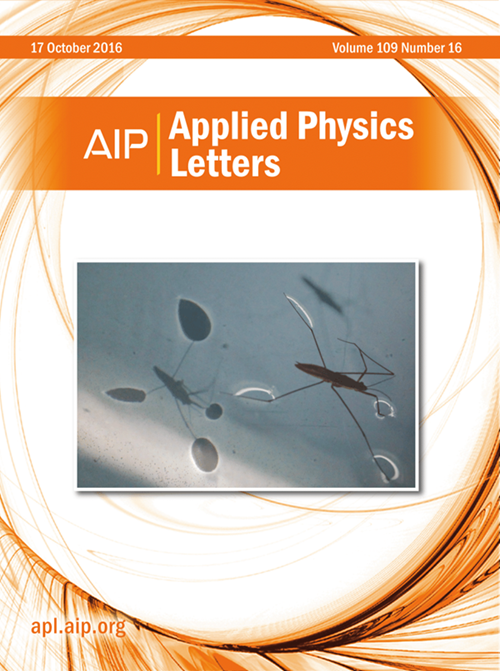Tailoring Pt nanoboxes with Bi atoms and SnO2 adatoms for efficient hydrogen evolution electrocatalysis
IF 3.5
2区 物理与天体物理
Q2 PHYSICS, APPLIED
引用次数: 0
Abstract
Engineering Pt-based nanocrystals at the atomic scale holds promise for achieving high-performance electrocatalysts, yet it remains challenging for multimetallic and hierarchical nanostructures. Herein, based on the PtSnBi intermetallic nanoplates with intrinsically isolated Pt, Sn, and Bi atoms, we present the rational design and synthesis of face-centered cubic (fcc) Pt nanoboxes, incorporating dilute Bi atoms within the lattice and SnO2 adatoms on the surface, to enhance acidic hydrogen evolution reaction (HER) electrocatalysis. The prepared SnO2@fcc-Pt0.9Bi0.1 catalyst exhibits ultralow overpotentials of 18.2 and 42.7 mV at 10 and 100 mA cm−2, respectively, accompanied by a favorable Tafel slope of 29.1 mV dec−1. Furthermore, it exhibits high stability, as evidenced by its well-maintained performance at 100 mA cm−2 for 24 h. Experimental characterization combined with density functional theory calculations indicates that hollow geometric engineering, Bi doping, and SnO2 surface modification collectively modulate the electronic structure of the active site and optimize the adsorption strength of hydrogen. Additionally, the engineering of Pt nanoboxes also enhances reaction kinetics, improves intrinsic per-site activity, and expands active surface areas. This work develops a strategy for engineering Pt-based catalysts to improve their HER performance.用Bi原子和SnO2原子裁剪Pt纳米盒用于高效析氢电催化
在原子尺度上设计基于pt的纳米晶体有望实现高性能的电催化剂,但对于多金属和分层纳米结构来说仍然是一个挑战。本文以具有Pt、Sn和Bi原子本质隔离的PtSnBi金属间纳米板为基础,设计和合成了面心立方(fcc) Pt纳米盒,在晶格内加入稀释的Bi原子,表面加入SnO2原子,以增强酸性析氢反应(HER)电催化。制备的SnO2@fcc-Pt0.9Bi0.1催化剂在10和100 mA cm−2下的过电位分别为18.2和42.7 mV, Tafel斜率为29.1 mV / dec−1。此外,它还表现出很高的稳定性,在100 mA cm−2条件下保持24小时的良好性能。实验表征结合密度泛函数理论计算表明,空心几何工程、Bi掺杂和SnO2表面改性共同调节了活性位点的电子结构,优化了氢的吸附强度。此外,Pt纳米盒的工程也增强了反应动力学,提高了内在的每位点活性,并扩大了活性表面积。这项工作开发了一种基于pt的催化剂的工程策略,以提高其HER性能。
本文章由计算机程序翻译,如有差异,请以英文原文为准。
求助全文
约1分钟内获得全文
求助全文
来源期刊

Applied Physics Letters
物理-物理:应用
CiteScore
6.40
自引率
10.00%
发文量
1821
审稿时长
1.6 months
期刊介绍:
Applied Physics Letters (APL) features concise, up-to-date reports on significant new findings in applied physics. Emphasizing rapid dissemination of key data and new physical insights, APL offers prompt publication of new experimental and theoretical papers reporting applications of physics phenomena to all branches of science, engineering, and modern technology.
In addition to regular articles, the journal also publishes invited Fast Track, Perspectives, and in-depth Editorials which report on cutting-edge areas in applied physics.
APL Perspectives are forward-looking invited letters which highlight recent developments or discoveries. Emphasis is placed on very recent developments, potentially disruptive technologies, open questions and possible solutions. They also include a mini-roadmap detailing where the community should direct efforts in order for the phenomena to be viable for application and the challenges associated with meeting that performance threshold. Perspectives are characterized by personal viewpoints and opinions of recognized experts in the field.
Fast Track articles are invited original research articles that report results that are particularly novel and important or provide a significant advancement in an emerging field. Because of the urgency and scientific importance of the work, the peer review process is accelerated. If, during the review process, it becomes apparent that the paper does not meet the Fast Track criterion, it is returned to a normal track.
 求助内容:
求助内容: 应助结果提醒方式:
应助结果提醒方式:


